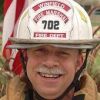Monday, Nov. 21, 2016, was beautiful fall morning in Wichita, Kansas, where members of the Wichita Fire Department, city officials, family survivors and guests gathered near downtown Wichita to honor four fallen Wichita firefighters.
A memorial stone bearing the names of the fallen was a reminder to all of the great sacrifice that was made at this location on this date 48 years ago. Surviving family members were presented a memorial plaque engraved with the names of their loved ones.
On Thursday, Nov. 21, 1968 at 9:12 p.m., a passer-by reported a fire at the Yingling Chevrolet auto dealership. The first units arrived on scene at 9:14 p.m., and had transmitted a second alarm while pulling out of fire station 2 quartered two blocks away.
Heavy dark smoke was reported to be showing from the structure. Firefighters stretched lines into the building and encountered heavy smoke in the service bay area.
When the alarm was received, Fire Chief Thomas McGaughey and his wife were celebrating their 36th wedding anniversary at a friend’s home along with Chief Inspector Merle Wells. Both immediately responded to the alarm.
A short time later, Chief McGaughey, Chief Wells and Firefighter Dale Mishler, the chief’s driver, made entry into the showroom floor to devise a plan for attacking fire.
Six minutes on scene
It was reported that no smoke or heat was present upon their entry, and the showroom lights were still on. But heavy fire was found in the cockloft space above, which was used for parts storage.
They were then joined by Firefighter Jimmy Austin, and probationary Firefighter Michael Corn. Corn had just graduated from the fire academy; this was his first call. He was requested to retrieve an attic ladder.
About 30 seconds after he exited the building a thunderous crash occurred; the entire roof over the showroom floor had collapsed with heavy fire now showing.
Approximately six minutes after arriving on-scene the bowstring truss roof collapsed claiming the lives of McGaughey, Wells, Mishler and Austin. About six other firefighters who were in or near the structure were briefly trapped but quickly rescued.
It was later determined that a significant delay in reporting this fire had occurred. Employees noted light smoke in the building as early as 8:30 p.m., but were focused on removing vehicles from the building and did not turn in the alarm.
This fire is historically significant as it was the first recognized collapse of a bowstring truss roof that claimed multiple firefighters lives. This would also prove to be a lesson that the American fire service would not fully learn for decades, regarding the extreme danger that fire poses to a trussed roof or floor system.
Ten years later, on Aug. 2, 1978, six firefighters were killed at a supermarket fire in New York City when the bowstring truss roof collapsed during firefighting operations.
And again, 10 years later, on July 1, 1988, five firefighters were killed when the bowstring truss roof collapsed at a Ford Dealership fire in Hackensack, New Jersey. This fire is eerily similar to the Yingling Chevrolet fire and is a must-read for all firefighters.
Never forget, never trust
If these fallen brothers could speak to us today, what do you suppose they would say? I believe they would tell us to “learn from our sacrifice.”
Training within the fire service regarding the dangers of truss construction was basically nonexistent prior to the 1960s and 1970s. However, since the 1980s, the dangers of truss construction in both traditional and lightweight engineered structural components have been well documented.
As stated by retired FDNY Chief Vincent Dunn, ”Never trust a truss.” This concept is straight forward. There is no margin of safety when fire enters the truss space.
Never under estimate the weakness of a trussed floor or roof. Failure can occur in as little as 4 to 6 minutes after fire exposure. A risk-versus-gain assessment must always be accomplished during size-up.
A key part of your size-up is to determine the type of construction present and the fire’s location. If fire has involved the truss space of either the roof or floor areas, this should be a no-go situation for firefighters.
Have standard operating guidelines addressing this in place.
It is important that we remember and learn the lessons from the past. These lesson must be taught to the newer generations of firefighter, or they are doomed to be repeated.
By teaching these lessons, we honor those who have gone before us. And we help preserve the lives of those who now serve and those who are yet to serve.













